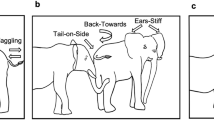Abstract
BATS of the species Myotis lucifugus use short frequency-modulated (FM) ultrasonic pulses for echolocation. The duration, repetition rate and frequency of these pulses vary from time to time depending upon whether the animal is searching for, approaching or actually capturing its prey. The bat emits 2–5 ms pulses at a rate of 10–20 s−1 with the frequency of each pulse sweeping approximately one octave from 80 to 40 kHz during the searching and cruising flight; it produces 0.3–1.0 ms pulses at a rate of 150–250 s−1 with a downward-sweep FM from 40–20 kHz immediately before avoidance of obstacles or capture of a prey1,2. Among the laryngeal muscles of the bat, the cricothyroid muscle (CTM) in particular, is highly developed and is essential in producing the intense orientation pulses1,3. The CTM not only discharges action potentials before the vocalisation3–5, but also during the acoustic stimulus6,7. The latter phenomenon is called the acoustic laryngeal muscle reflex and might serve as a negative feedback to stabilise the performance of the vocalisation system6. Comparative studies of the properties of the middle ear and laryngeal muscles revealed significant differences between these two muscles (refs 6 and 7 and P.H.-S.J., J.O., and N. Suga, in preparation). We found that CTM fibres were more sensitive to 4 ms FM signals sweeping downward with a range of 10 or 20 kHz across their best frequencies (BFs) than to pure tones.
This is a preview of subscription content, access via your institution
Access options
Subscribe to this journal
Receive 51 print issues and online access
$199.00 per year
only $3.90 per issue
Buy this article
- Purchase on Springer Link
- Instant access to full article PDF
Prices may be subject to local taxes which are calculated during checkout
Similar content being viewed by others
References
Griffin, D. R., Listening in the Dark (Yale University Press, Yale, 1958).
Griffin, D. R., Symp. Zool. Soc. Lond., 7, 61–72 (1962).
Novick, A., and Griffin, D. R., J. exp. Zool., 148, 125–145 (1961).
Suthers, R. A., and Fattu, J. M., Am. Zool., 13, 1215–1226 (1973).
Schuller, G., and Suga, N., J. comp. Physiol., 107, 253–262 (1976).
Jen, P. H.-S., and Suga, N., Science, 191, 950–952 (1976).
Jen, P. H.-S., and Suga, N., Nat. Sci. Coun. Month (China), 4, 2606–2617 (1976).
Suga, N., J. Physiol., Lond. 198, 51–80 (1968).
Suga, N., and Schlegel, P., J., acoust. Soc. Am., 54, 174–190 (1973).
Suga, N., and Jen, P. H.-S., J. exp. Biol., 62, 277–311 (1975).
Shimozawa, T., Suga, N., Hendler, P., and Schuetze, S., J. exp. Biol., 60, 53–69 (1974).
Suga, N., J. Physiol., Lond., 179, 26–53 (1965); 181, 671–700 (1975); 200, 555–574 (1969).
Author information
Authors and Affiliations
Rights and permissions
About this article
Cite this article
JEN, PS., OSTWALD, J. Response of cricothyroid muscles to frequency-modulated sounds in FM bats, Myotis lucifugus. Nature 265, 77–78 (1977). https://doi.org/10.1038/265077a0
Received:
Accepted:
Issue Date:
DOI: https://doi.org/10.1038/265077a0
This article is cited by
-
Adaptive mechanisms underlying the bat biosonar behavior
Frontiers in Biology (2010)
-
Electrophysiological properties of the acoustic middle ear and laryngeal muscle reflexes in the awake echolocating FM-bats,Myotis lucifugus
Journal of Comparative Physiology ? A (1978)
Comments
By submitting a comment you agree to abide by our Terms and Community Guidelines. If you find something abusive or that does not comply with our terms or guidelines please flag it as inappropriate.



